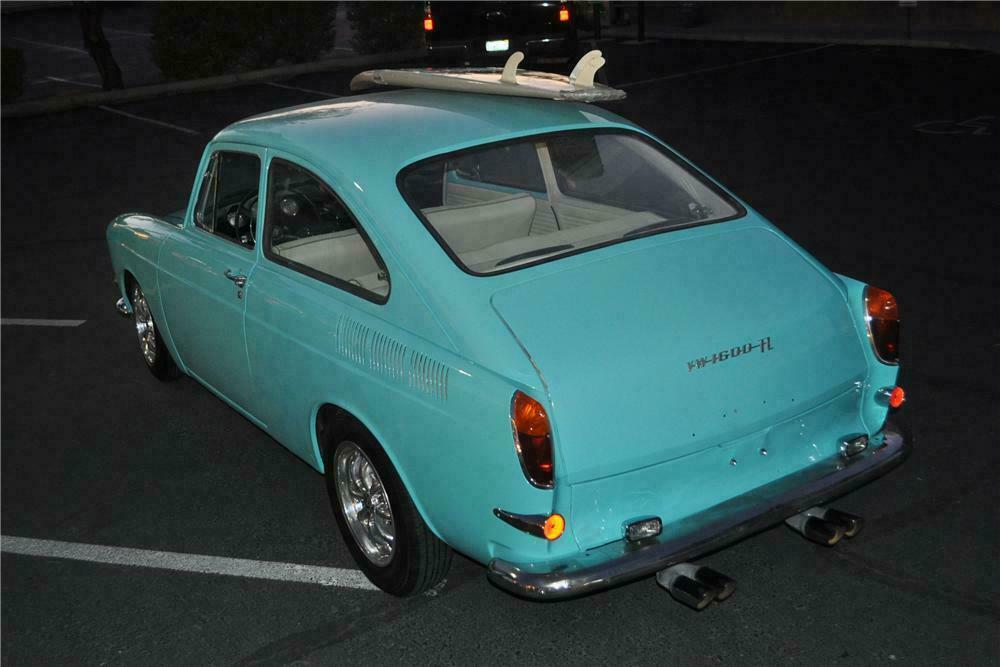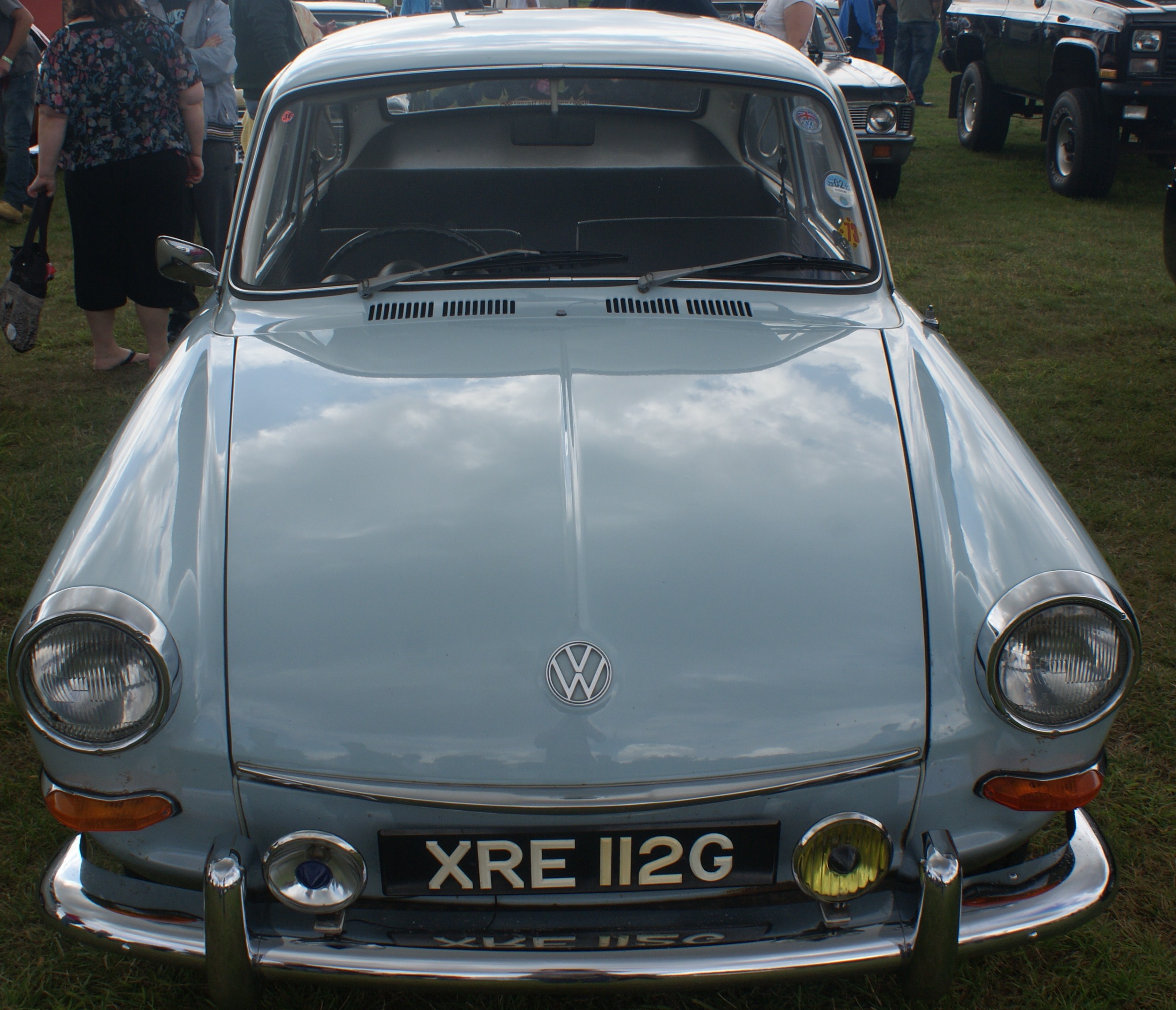
‘N’ models have single-speed wipers, no parking lights, small front indicator ‘bullets’, pre-heated intake air, opening quarter lights optional extra. Notchback and Variant (Squareback) available with either 1500N (54 bhp at 4,200 rpm, 7.8:1 CR, torque 83.2 ft.lbs. Swing-axle half-shafts twin lower full-width torsion bars on front two brake cylinders per front wheel opening rear side windows, central rear armrest on Notchback. 6-volt electrics, side parking lamps, variable speed wipers. The vehicle had a 1493 cc engine, 7.2:1 CR, 53 bhp at 4,000 rpm with side-draft 32 PHN carb torque exceeds 80 ft.lbs between 1,500 and 2,800 rpm. The VW TNotchback, ‘Station Car’ and Convertible were announced during the Frankfurt Motor Show in Germany (convertible never entered production). Rear brakes were always leading / trailing shoe drums. These have 4-stud wheels (4 x 130 mm PCD) with 8 cooling slots. In August ’65 (the ’66 model year) these were replaced by disc brakes, coinciding with the introduction of the Fastback and 1600 engine (Australian built models retained drum front brakes until August 1967). The original Type 3 with 5-stud wheels (5 x 205 mm PCD) used twin leading shoe drum brakes at the front. In each of the 3 variants (Notchback, Squareback, and Fastback) as well as the Type 2’s from 1968 on, the engine was located under a panel in the rear trunk. The Type 3 offered both front and rear enclosed luggage areas, with greater volume and cargo accessibility via both the boot (trunk) and the bonnet (hood). In 1968 the rear suspension was upgraded to double jointed CV joint semi-trailing arm suspension (sometimes called IRS by VW enthusiasts to differentiate it from the previous ( IRS ) swing-axle type), a design feature that previously appeared on the VW Type 2 in 1967. The complete front suspension unit is rubber-mounted to the car’s floor pan.
#Vw type 3 notchback full#
The Type 3’s torsion bars are cross-mounted in the lower tube, so that each individual torsion bar spans the full width of the car, the upper tube containing an anti-roll bar that connects the upper trailing links to each other. Also introduced for 1968 was a fully automatic transmission.Ī notable advance from the VW Beetle to the Type 3 was the front suspension - although similar to the Type 1, it was the first Volkswagen front suspension to incorporate transverse round torsion bars, as opposed to the Type 1’s torsion leaves.
#Vw type 3 notchback series#
A similar Bosch injection system was used in the later Type 4 VW 411, some models of the Porsche 914, Opel Admiral, Diplomat and Commodore, and available for the Volvo 1800E/ES, 142E, and certain 1972-75 140 and 164 series cars (see Volvo P1800). The Bosch D-Jetronic system was offered on the Volkswagen 1600 TE & LE version (E designating “ Einspritzung” or “injection” in German).

The VW Type 3 engine received a larger displacement (1.6 L) for 1966 (August ’65) and in 1968 became the world’s first volume production car to feature electronic fuel injection – pioneered by Bosch.

In August 1963 VW introduced single- and twin-carburetor versions, respectively the Volkswagen 1500 ‘N’ (Normal), rated at 45 PS (33 kW 44 hp), and the 1500 ‘S’ (Super), 54 PS (40 kW 53 hp) which had high-compression (8.5:1) domed 83 mm pistons and twin downdraught 32 mm Solex PDSIT carburetors for more power. The original Volkswagen 1500 engine used a single side-draught 32 mm Solex PHN carburetor. Unlike the VW Bug (Type 1), the Type 3 engine and transmission unit was mounted into a subframe (which contained the complete rear suspension), in turn rubber-mounted to the floor pan and body, thereby isolating vibration and road noise from the passenger space.


It used a similar transmission to the VW Beetle but with higher ratios (4.125 R&P v 4.375 R&P) and longer axles. The engine’s displacement would eventually increase to 1.6 L (1584 cc). This reduced the height of the engine profile, allowed greater cargo volume, and earned the nicknames of “Pancake” or “Suitcase” engine. While the long block remained the same as the Type 1, the engine cooling was redesigned by putting the fan on the end of the crankshaft instead of on the generator. The VW Type 3 engine was initially a 1.5 L (1493 cc) engine based on the air-cooled 1192 cc flat-4 found in the Type 1, but given a 69 mm stroke it became the basis for the 1300 cc and 1600 cc engines that followed in the later Beetle (Type 1) and Volkswagen Type 2 T1 and T2 Bus.


 0 kommentar(er)
0 kommentar(er)
